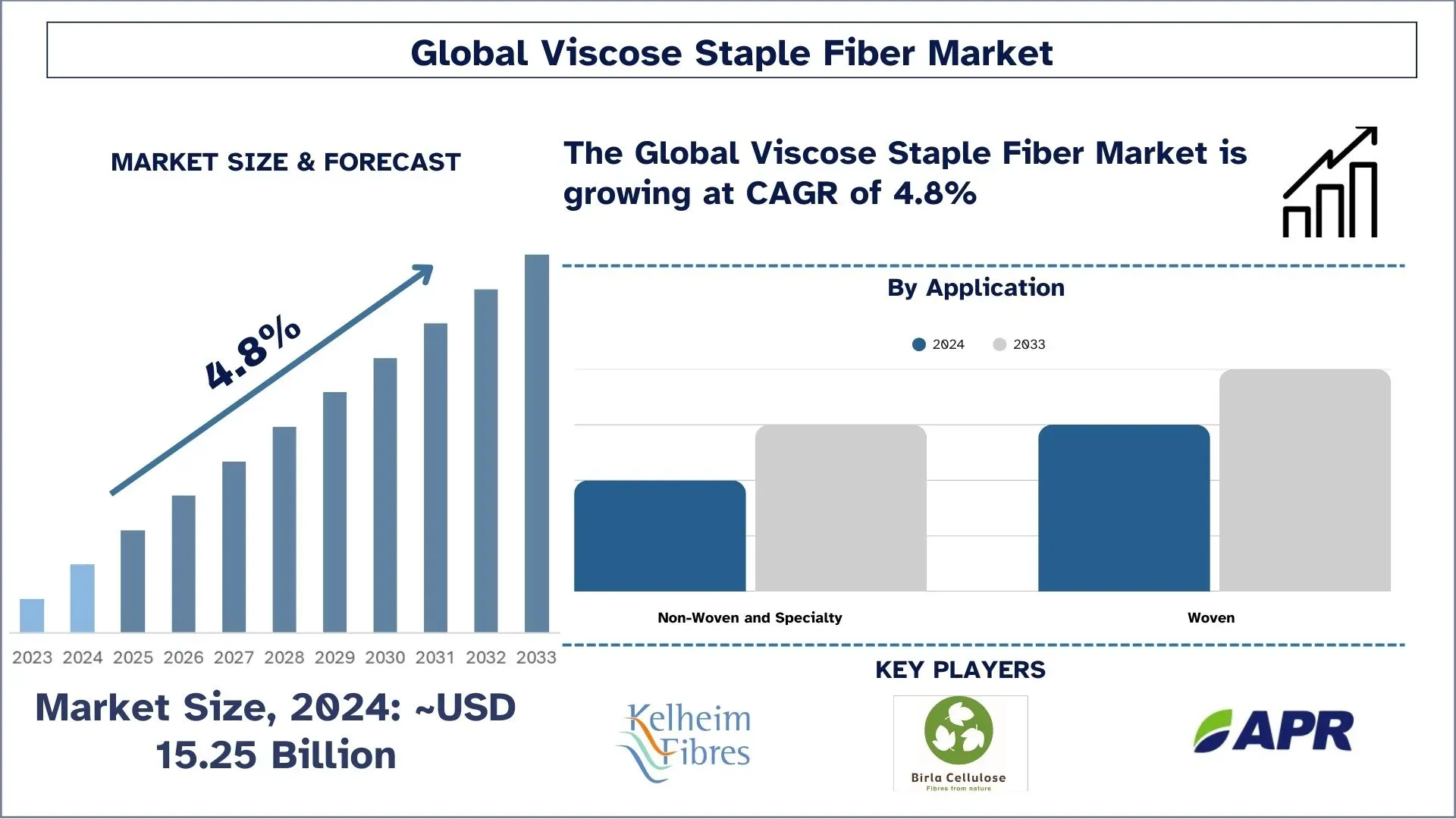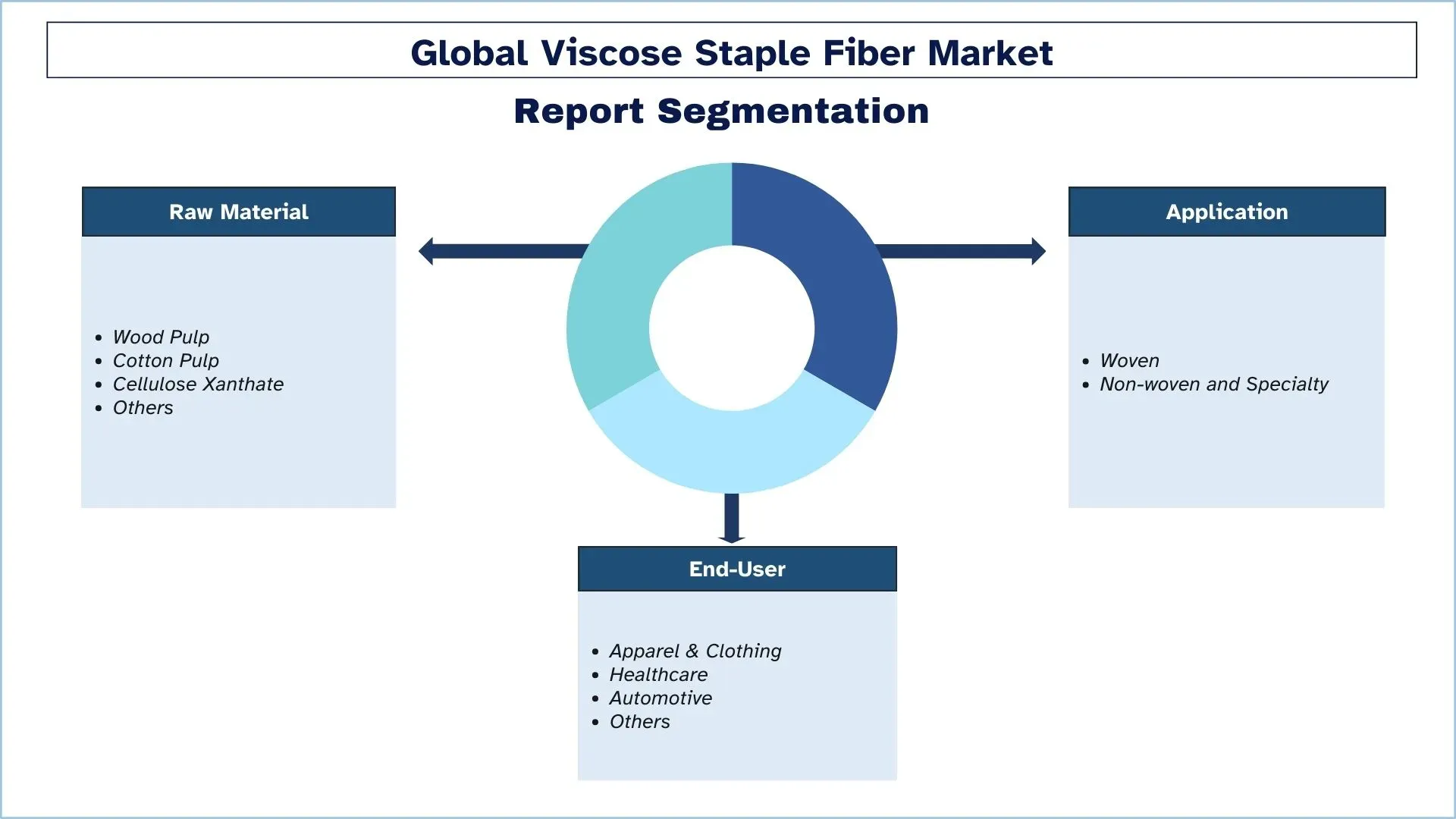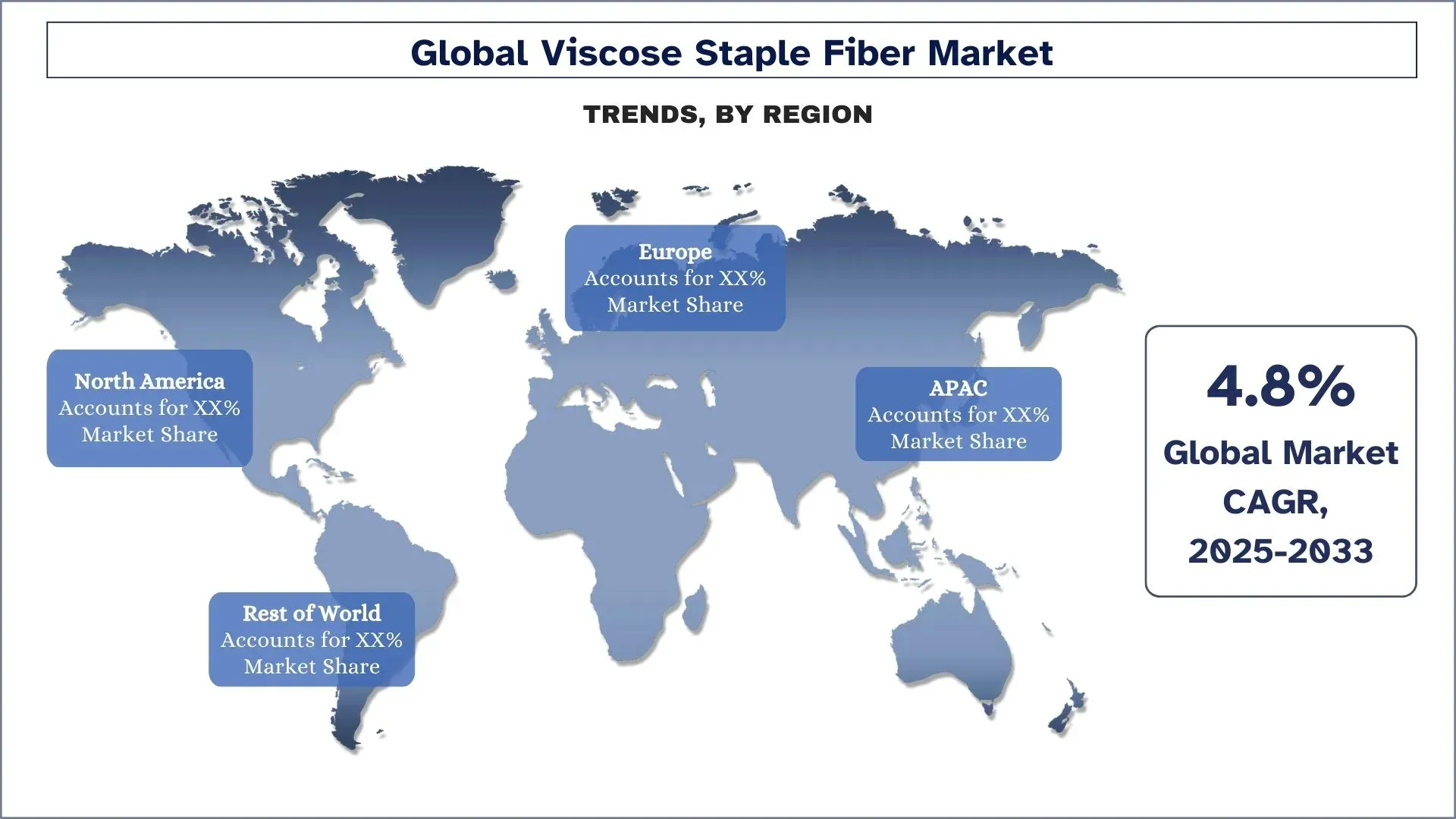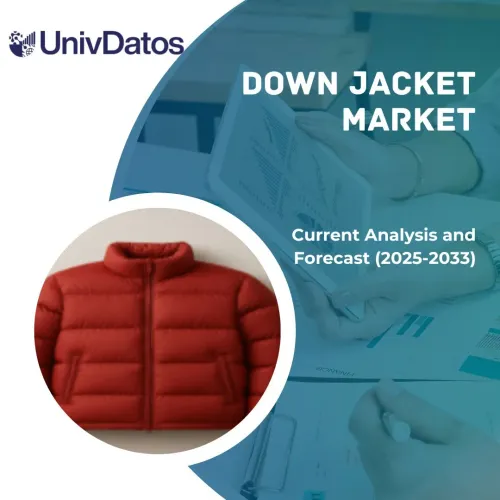
비스코스 스테이플 섬유 시장 규모 및 예측
비스코스 스테이플 섬유 시장은 2024년에 약 152억 5천만 달러로 평가되었으며, 섬유 및 의류 산업의 수요 증가로 인해 예측 기간 (2025-2033) 동안 약 4.8%의 상당한 연평균 성장률(CAGR)로 성장할 것으로 예상됩니다.
비스코스 스테이플 섬유 시장 분석
글로벌 비스코스 스테이플 섬유(VSF) 시장은 섬유 생산업체, 의류 제조업체, 가정용 가구 회사가 시장 요구 사항을 확대함에 따라 꾸준히 발전하고 있습니다. VSF 산업은 소비자들이 부드러움, 통기성 및 생분해성 특성으로 인해 면보다 선호함에 따라 인기가 높아지고 있습니다. 이 시장은 지속 가능한 제조 분야에서 현대적인 생산 방법과 확장되는 자원을 통합하여 경쟁력을 유지하고 있습니다. VSF 시장은 전 세계, 특히 신흥 경제국에서 확장되는 섬유 시장을 통해 환경에 대한 소비자 요구를 충족할 준비가 되어 있습니다. 시장의 미래 성장 패턴은 이러한 현재 개발 패턴과 환경적으로 지속 가능한 섬유 제조로의 지속적인 전환에 의해 영향을 받을 것입니다.
비스코스 스테이플 섬유 시장 동향
이 섹션에서는 당사 연구 전문가가 식별한 비스코스 스테이플 섬유 시장의 다양한 부문에 영향을 미치는 주요 시장 동향에 대해 논의합니다.
지속 가능성 및 친환경 생산 관행으로의 전환.
비스코스 스테이플 섬유(VSF) 시장은 환경적으로 책임 있는 제조 방식에 대한 소비자 관심이 증가함에 따라 성장이 가속화되고 있습니다. 섬유 산업의 경영진은 이러한 시스템이 폐기물 배출량을 줄이고 화학 물질을 절감하기 때문에 제조를 위한 폐쇄 루프 시스템에 상당한 자금을 투자합니다. 전 세계적으로 강화된 환경 기준과 천연 성형 가능 섬유에 대한 섬유 산업의 요구로 인해 VSF 제조업체는 용매 회수 시스템 및 책임감 있는 자재 소싱을 포함한 환경 친화적인 생산 기술을 구현합니다. 시장 변화는 증가된 지속 가능성 기준을 통해 발생하며, 이로 인해 제조업체는 환경 요구 사항에 부합하기 때문에 VSF를 더 자주 선택하게 됩니다.
비스코스 스테이플 섬유 시장 산업 세분화
이 섹션에서는 글로벌 비스코스 스테이플 섬유 시장 보고서의 각 부문의 주요 동향에 대한 분석과 함께 2025-2033년에 대한 글로벌, 지역 및 국가 수준의 예측을 제공합니다.
목재 펄프 부문은 비스코스 스테이플 섬유 시장보다 더 높은 연평균 성장률(CAGR)을 보일 것으로 예상됩니다.
원자재를 기준으로 비스코스 스테이플 섬유 시장은 목재 펄프, 면 펄프, 셀룰로오스 크산테이트 등으로 분류됩니다. 목재 펄프 부문은 시장이 가용성과 품질 모두에 직접적으로 의존하기 때문에 비스코스 스테이플 섬유 시장에서 가장 큰 점유율을 차지했습니다. 지속 가능한 방식으로 조달된 목재 펄프에 대한 시장 수요는 환경 문제 증가로 인해 계속 증가하고 있습니다. VSF 산업의 지속 가능한 접근 방식은 신흥 시장이 VSF 생산 능력을 구축하고 있기 때문에 책임 있는 펄프 소싱을 촉진하는 동시에 프리미엄 펄프 생산에 대한 수요를 높입니다.
의류 시장은 시장에서 가장 큰 점유율을 차지합니다.
최종 사용자를 기준으로 비스코스 스테이플 섬유 시장은 의류, 의료, 자동차 등으로 나뉩니다. 의류 시장은 비스코스 스테이플 섬유 시장에서 가장 큰 점유율을 차지했으며, 이 부문은 비스코스 스테이플 섬유의 가장 큰 소비자로 시장 확대를 주도하고 있습니다. VSF는 특히 패션 브랜드가 친환경 소재 사용에 집중하는 이 시기에 가볍고 저렴한 특성 때문에 패션 응용 분야에서 최고의 선택으로 남아 있습니다. VSF는 소비자 시장에서 지속 가능한 의류에 대한 수요가 증가함에 따라 생분해성 및 재생 가능하기 때문에 중요한 지속 가능한 섬유 소재로 기능합니다.

아시아 태평양 지역은 2024년에 시장에서 상당한 점유율을 차지합니다.
아시아 태평양 비스코스 스테이플 섬유(VSF) 시장은 중국, 인도, 방글라데시의 섬유 및 의류 산업이 이 소재를 대량으로 요구하기 때문에 가장 큰 규모와 가장 빠른 확장을 보여줍니다. 이 시장은 두 가지 핵심 동인, 즉 이 지역이 섬유 제조를 통제하고 소비자의 지속 가능한 섬유에 대한 수요가 증가함에 따라 모멘텀을 얻고 있습니다. 친환경적인 소비자들은 쉽게 생분해되는 지속 가능한 천연 섬유 제품을 선택하기 때문에 VSF 채택을 추진하고 있습니다. 아시아 태평양 VSF 시장은 패션 및 가정용 직물, 의료용 직물 산업 전반에 걸쳐 확장되는 응용 분야를 지원하는 수요 및 생산 개발로 인해 상승 추세를 유지할 것입니다.
중국이 아시아 태평양 비스코스 스테이플 섬유 시장을 지배합니다.
중국은 국내외 시장 모두에 상당한 양의 비스코스 스테이플 섬유를 생산하고 수출하기 때문에 VSF 시장 부문 내에서 주요 위치를 차지하고 있습니다. 섬유 운영에 대한 상당한 자금 지원과 함께 번성하는 제조 능력을 통해 중국은 전 세계 VSF 제품 공급을 확고히 장악하고 있습니다. 국내 및 국제 환경 내에서 VSF에 대한 시장 요구 사항이 증가함에 따라 생산업체는 생산 혁신 개선으로 나아가고 있습니다. 중국에서는 환경 문제 증가와 규제 기준, 친환경 제품에 대한 소비자 기대치 상승으로 인해 VSF 산업의 지속 가능한 변화가 나타나고 있습니다. 산업 변화는 생산업체에게 유망한 시장 잠재력을 제공하지만 환경 지속 가능성을 훼손하지 않고 성장을 달성해야 합니다.

비스코스 스테이플 섬유 시장 산업 경쟁 환경
비스코스 스테이플 섬유 시장은 경쟁이 치열하며 여러 글로벌 및 국제 기업이 있습니다. 주요 기업은 파트너십, 계약, 협업, 신제품 출시, 지리적 확장, 인수 합병 등 시장 입지를 강화하기 위해 다양한 성장 전략을 채택하고 있습니다.
상위 비스코스 스테이플 섬유 시장 회사
시장에서 활동하는 주요 업체로는 Asia Pacific Rayon Limited, Birla Cellulose, Glanzstoff, Jilin Chemical Fiber Group Co. Ltd, Kelheim Fibres GmbH, LENZING AG, Nanjing Chemical Fibre Co. Ltd, Sateri, SNIACE Group, Xinjiang Zhongtoi Chemical Co. Ltd 등이 있습니다.
비스코스 스테이플 섬유 시장의 최근 개발 사항
- 2023년 5월 - Kelheim Fibres GmbH와 Santoni Spa는 고품질 성능 비스코스 섬유와 첨단 기계 기술로 만든 지속 가능하고 고급스러운 생리용 속옷을 개발하기 위해 협력했습니다. 이 제품은 더 부드러운 외부 레이어와 고급 목재 기반 섬유로 만든 인레이 부분으로 구성됩니다.
- 2022년 11월 - LENZING Group은 LENZING ECOVERO 브랜드 섬유 300,000톤 생산이라는 이정표를 달성했으며, 수요 증가로 인해 2023년까지 생산 능력을 두 배로 늘리는 것을 목표로 하고 있습니다.
비스코스 스테이플 섬유 시장 보고서 범위
세부 정보 | |
기준 연도 | 2024 |
예측 기간 | 2025-2033 |
성장 모멘텀 | 연평균 성장률 4.8%로 가속화 |
2024년 시장 규모 | 152억 5천만 달러 |
지역 분석 | 아시아 태평양, 유럽, 아시아 태평양, 기타 지역 |
주요 기여 지역 | 아시아 태평양 지역은 예측 기간 동안 가장 높은 연평균 성장률(CAGR)로 성장할 것으로 예상됩니다. |
주요 국가 포함 | 미국, 캐나다, 독일, 프랑스, 영국, 스페인, 이탈리아, 중국, 일본, 인도 |
Asia Pacific Rayon Limited, Birla Cellulose, Glanzstoff, Jilin Chemical Fiber Group Co. Ltd, Kelheim Fibres GmbH, LENZING AG, Nanjing Chemical Fibre Co. Ltd, Sateri, SNIACE Group, Xinjiang Zhongtoi Chemical Co. Ltd 등 | |
보고서 범위 | 시장 동향, 동인 및 제약; 수익 추정 및 예측; 세분화 분석; 수요 및 공급 측면 분석; 경쟁 환경; 회사 프로필 |
다루는 세그먼트 | 원자재별, 애플리케이션별, 최종 사용자별, 지역/국가별 |
비스코스 스테이플 섬유 시장 보고서를 구매해야 하는 이유:
- 이 연구에는 인증된 주요 산업 전문가가 검증한 시장 규모 측정 및 예측 분석이 포함되어 있습니다.
- 이 보고서는 전체 산업 성과에 대한 빠른 검토를 한눈에 제공합니다.
- 이 보고서는 주요 비즈니스 재무, 제품 포트폴리오, 확장 전략 및 최근 개발에 중점을 두고 주요 산업 동료에 대한 심층 분석을 다룹니다.
- 업계에 널리 퍼져 있는 동인, 제약, 주요 동향 및 기회에 대한 자세한 조사.
- 이 연구는 다양한 세그먼트에 걸쳐 시장을 포괄적으로 다룹니다.
- 업계에 대한 심층적인 지역 수준 분석.
맞춤화 옵션:
글로벌 비스코스 스테이플 섬유 시장은 요구 사항 또는 기타 시장 세그먼트에 따라 추가로 맞춤화할 수 있습니다. 이 외에도 UnivDatos는 귀하의 비즈니스 요구 사항이 있을 수 있음을 이해하고 있으므로 귀하의 요구 사항에 완벽하게 맞는 보고서를 얻으려면 언제든지 저희에게 연락하십시오.
목차
비스코스 스테이플 파이버 시장 분석을 위한 연구 방법론 (2023-2033)
당사는 전 세계 주요 지역에서 비스코스 스테이플 파이버 시장의 적용을 평가하기 위해 과거 시장을 분석하고, 현재 시장을 추정하고, 글로벌 비스코스 스테이플 파이버 시장의 미래 시장을 예측했습니다. 당사는 과거 시장 데이터를 수집하고 현재 시장 규모를 추정하기 위해 철저한 2차 연구를 수행했습니다. 이러한 통찰력을 검증하기 위해 수많은 조사 결과와 가정을 신중하게 검토했습니다. 또한 비스코스 스테이플 파이버 시장 가치 사슬 전반에 걸쳐 업계 전문가와 심층적인 1차 인터뷰를 진행했습니다. 이러한 인터뷰를 통해 시장 수치를 검증한 후, 당사는 하향식 및 상향식 접근 방식을 사용하여 전체 시장 규모를 예측했습니다. 그런 다음 시장 세분화 및 데이터 삼각 측량 방법을 사용하여 산업 부문 및 하위 부문의 시장 규모를 추정하고 분석했습니다.
시장 엔지니어링
당사는 데이터 삼각 측량 기법을 사용하여 전체 시장 추정치를 확정하고 글로벌 비스코스 스테이플 파이버 시장의 각 세그먼트 및 하위 세그먼트에 대한 정확한 통계 수치를 도출했습니다. 당사는 원자재, 애플리케이션, 최종 사용자 및 글로벌 비스코스 스테이플 파이버 시장 내 지역을 포함한 다양한 매개변수 및 추세를 분석하여 데이터를 여러 세그먼트 및 하위 세그먼트로 분할했습니다.
글로벌 비스코스 스테이플 파이버 시장 연구의 주요 목표
이 연구는 글로벌 비스코스 스테이플 파이버 시장의 현재 및 미래 추세를 파악하여 투자자를 위한 전략적 통찰력을 제공합니다. 또한 지역 시장의 매력도를 강조하여 업계 참여자들이 미개척 시장을 활용하고 선점 우위를 확보할 수 있도록 합니다. 연구의 다른 정량적 목표는 다음과 같습니다.
- 시장 규모 분석: 가치 (USD) 측면에서 글로벌 비스코스 스테이플 파이버 시장 및 해당 세그먼트의 현재 및 예측 시장 규모를 평가합니다.
- 비스코스 스테이플 파이버 시장 세분화: 이 연구는 원자재, 애플리케이션, 최종 사용자 및 지역별로 시장을 세분화합니다.
- 규제 프레임워크 및 가치 사슬 분석: 비스코스 스테이플 파이버 시장 산업의 규제 프레임워크, 가치 사슬, 고객 행동 및 경쟁 환경을 검토합니다.
- 지역 분석: 아시아 태평양, 유럽, 북미 및 기타 지역과 같은 주요 지역에 대한 자세한 지역 분석을 수행합니다.
- 회사 프로필 및 성장 전략: 비스코스 스테이플 파이버 시장의 회사 프로필과 빠르게 성장하는 시장을 유지하기 위해 시장 리더가 채택한 성장 전략입니다.
자주 묻는 질문 자주 묻는 질문
Q1: 비스코스 스테이플 섬유 시장의 현재 규모와 성장 잠재력은 무엇입니까?
2024년 현재 전 세계 비스코스 스테이플 섬유 시장은 약 152억 5천만 달러로 평가되며 2033년까지 연평균 성장률 4.8%로 성장할 것으로 예상됩니다.
Q2: 비스코스 스테이플 섬유 시장 성장의 주요 동인은 무엇입니까?
전 세계 패션 및 가정용 섬유 분야에서 부드럽고 통기성이 좋으며 비용 효율적인 직물에 대한 수요가 증가함에 따라 VSF 시장의 주요 동인으로 작용하고 있습니다. 소비자들이 면에 대한 반합성 섬유 대체재로 전환함에 따라 VSF는 다용도성과 저렴한 비용으로 인해 매력적인 솔루션을 제공합니다.
Q3: 원료별 비스코스 스테이플 섬유 시장 점유율이 가장 높은 시장은 어디입니까?
목재 펄프 부문은 원자재 부문별 글로벌 비스코스 스테이플 섬유 시장을 지배하고 있습니다.
Q4: 비스코스 스테이플 섬유 시장의 주요 트렌드는 무엇입니까?
생산자들이 폐쇄 루프 공정, 생분해성 섬유, 인증된 지속 가능한 소싱에 투자하면서 환경적으로 책임감 있는 제조로 향하는 추세가 증가하고 있습니다. 브랜드와 제조업체는 글로벌 지속 가능성 목표에 발맞춰 가치 사슬 전반에 걸쳐 조달 및 혁신 전략에 영향을 미치고 있습니다.
Q5: 비스코스 스테이플 섬유 시장을 지배할 지역은 어디입니까?
현재 APAC 지역이 전 세계 비스코스 스테이플 섬유 시장을 주도하고 있습니다.
Q6: 비스코스 스테이플 섬유 시장에서 가장 큰 과제는 무엇입니까?
VSF 산업은 기존 생산 방식과 관련된 수질 오염, 삼림 벌채, 화학 폐기물에 대한 감시가 강화되는 추세입니다. 특히 중국, 인도와 같은 주요 생산 국가에서 더욱 엄격해지는 환경 규제로 인해 기업들은 보다 친환경적인 기술과 투명한 공급망에 투자해야 하는 압박을 받고 있으며, 이는 운영의 복잡성과 비용 증가로 이어지고 있습니다.
Q7: 전 세계 비스코스 스테이플 섬유 시장의 주요 업체는 누구입니까?
비스코스 스테이플 섬유 시장의 혁신을 주도하는 주요 기업은 다음과 같습니다.
• Asia Pacific Rayon Limited
• Birla Cellulose
• Glanzstoff
• Jilin Chemical Fiber Group Co. Ltd
• Kelheim Fibres GmbH
• LENZING AG
• Nanjing Chemical Fibre Co. Ltd
• Sateri
• SNIACE Group
• Xinjiang Zhongtoi Chemical Co. Ltd
Q8: 기업이 비스코스 스테이플 섬유 시장에 투자할 때 고려해야 할 주요 요인은 무엇입니까?
비스코스 스테이플 섬유 시장에 투자할 때 기업은 원자재 가용성(특히 목재 펄프), 환경 규제, 생산 비용, 지역 수요 동향 및 지속 가능성 자격 증명을 포함한 여러 중요한 요소를 평가해야 합니다. 또한 경쟁 역학, 섬유 가공 기술 발전, 잠재적인 공급망 위험을 평가하는 것이 중요합니다. 이러한 영역에 대한 실사는 투자 위험을 완화하고 전략적 성장 기회를 발굴하는 데 도움이 될 수 있습니다.
Q9: 비스코스 스테이플 섬유의 새로운 지역 시장은 무엇이며, 기업은 왜 그 시장에 주목해야 할까요?
아시아 태평양 지역의 신흥 시장(특히 인도, 베트남, 인도네시아), 라틴 아메리카 및 동유럽 일부 지역은 섬유 수요 증가, 낮은 제조 비용 및 정부 지원 정책으로 인해 인기를 얻고 있습니다. 이러한 지역은 특히 글로벌 브랜드가 중국 이외의 다양한 소싱 및 생산 기지를 모색함에 따라 VSF 제조업체와 투자자에게 높은 성장 잠재력을 제공합니다. 이러한 시장을 주시하면 기업이 경쟁에서 앞서나가고 초기 투자 기회를 활용하는 데 도움이 될 수 있습니다.
관련 보고서
이 상품을 구매한 고객님들도 함께 구매하신 상품










